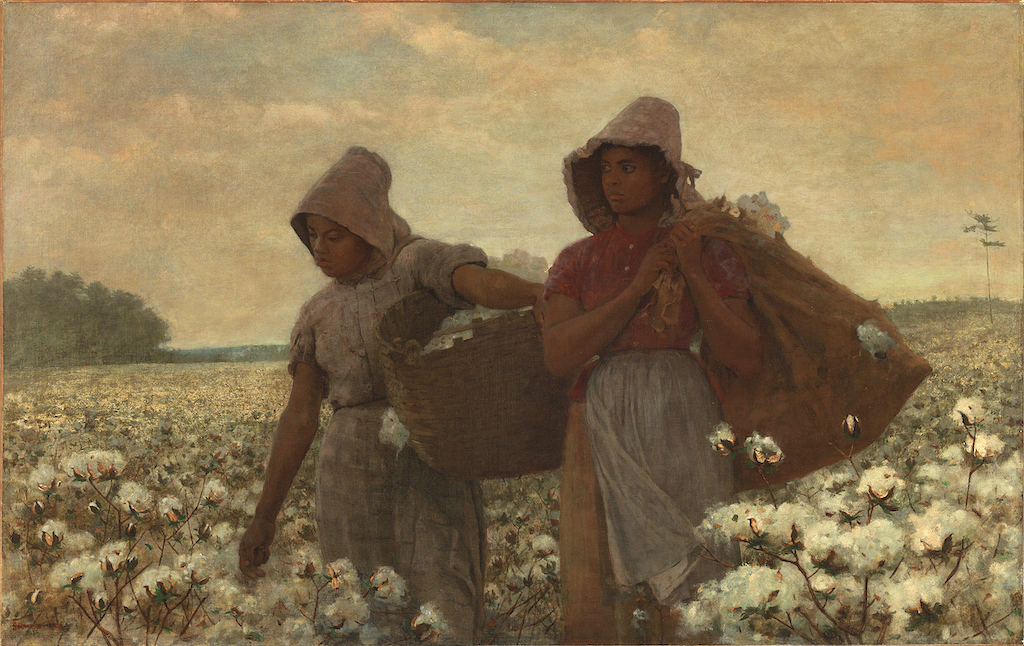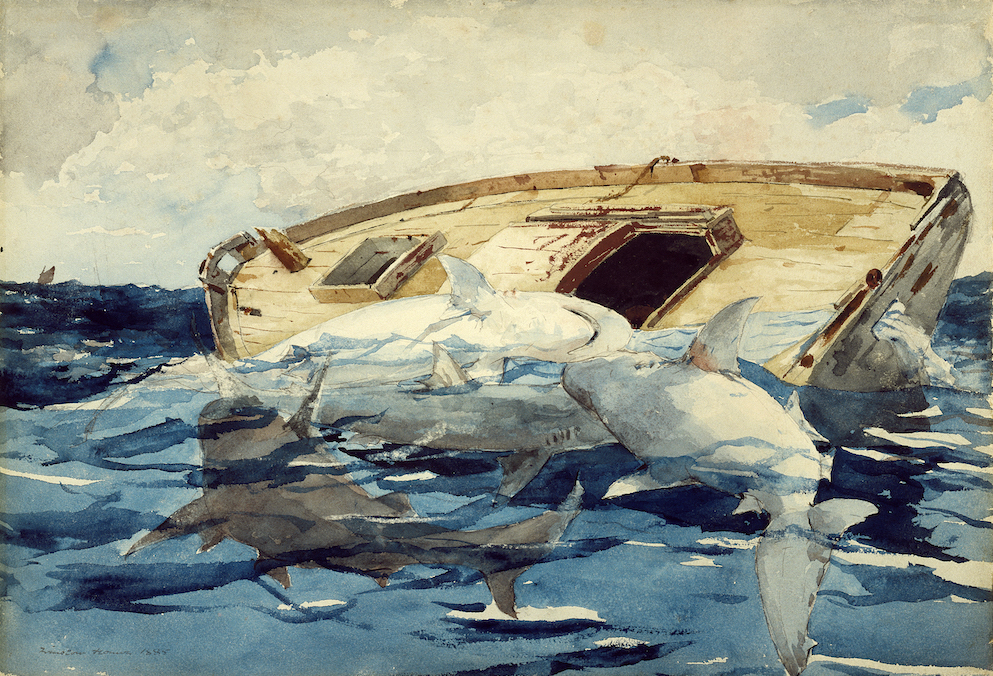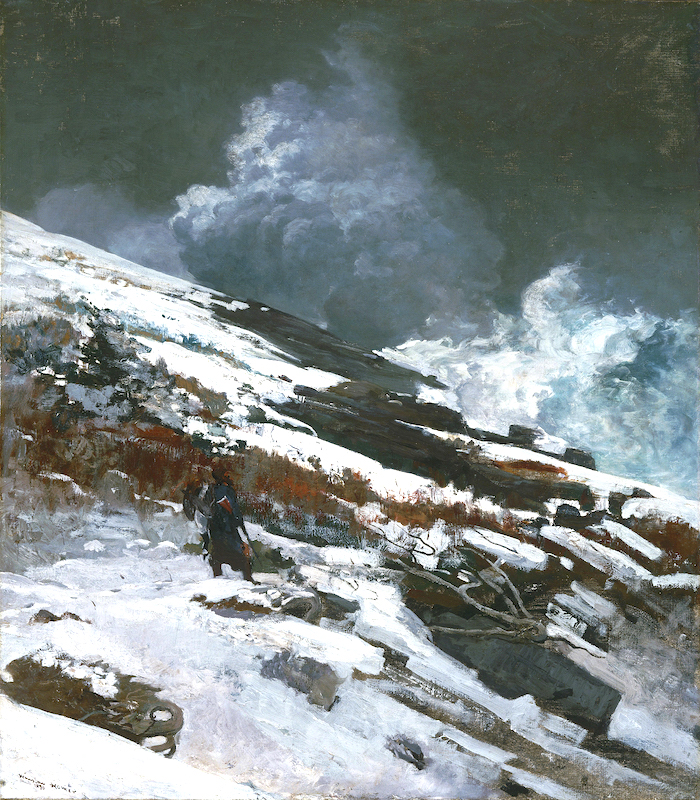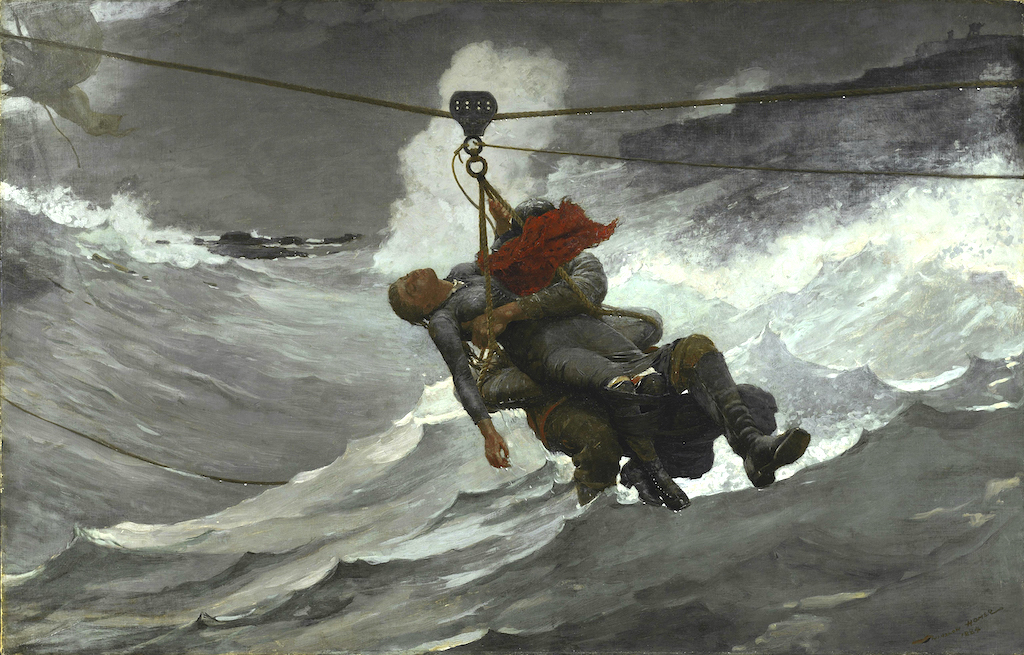Winslow Homer: Force of Nature, National Gallery review - dump the symbolism and enjoy the drama | reviews, news & interviews
Winslow Homer: Force of Nature, National Gallery review - dump the symbolism and enjoy the drama
Winslow Homer: Force of Nature, National Gallery review - dump the symbolism and enjoy the drama
Hot topics like slavery and colonialism given the ambiguous treatment

Across the pond Winslow Homer is a household name; in his day, he was regarded as the greatest living American painter. He was renowned especially for his seascapes and his most famous painting, The Gulf Stream, 1899/1906 (main picture) features in the National Gallery’s retrospective.
A small boat with a broken mast bobs about on stormy waters, at the mercy of the waves. Clinging to the deck is a lone sailor, a black man desperately scanning the horizon for help. He needs it; the sail lies in a useless heap and nothing else is on board beside a few sugarcanes. As if to emphasise the extremity of his plight, the boat is surrounded by sharks that dip and dive in waters flecked with blood. Is the man a runaway slave or is he an emblem of slavery in general? Homer’s pictures often contain references to hot topics, such as colonialism and the slave trade; but when asked to explain them, he always kept schtum – preferring ambiguity over explication.
Homer’s pictures often contain references to hot topics, such as colonialism and the slave trade; but when asked to explain them, he always kept schtum – preferring ambiguity over explication.
He started life as an illustrator before being appointed as a war artist embedded with Federal troops in the American Civil War. One can reasonably assume, then, that his sympathies lay with Unionists rather than Confederates. Dressing for Carnival was painted in 1877, the year Federal troops finally left the South. Two black women sew a man into the costume of the Lord of Misrule in preparation for Independence Day – an excuse to celebrate Black liberation. In reality, though, there wasn’t much to celebrate. When Homer revisited Virginia after the war, he discovered that life had scarcely improved for former slaves, many of whom now worked for a pittance on the plantations. In 1866 he set sail for Paris where two of his war paintings were included in the Exposition Universelle. Also on show was The Gleaners 1857 by Jean-Francois Millet, which must have inspired Homer’s painting of two black women toiling in the fields. The Cotton Pickers 1876 (pictured above) shows unusual respect for the women heroically silhouetted against the sky. Ironically, the picture was bought by an English cotton merchant. Did Homer’s sympathetic treatment convince him that abolition had transformed black lives into a bed of roses?
In 1866 he set sail for Paris where two of his war paintings were included in the Exposition Universelle. Also on show was The Gleaners 1857 by Jean-Francois Millet, which must have inspired Homer’s painting of two black women toiling in the fields. The Cotton Pickers 1876 (pictured above) shows unusual respect for the women heroically silhouetted against the sky. Ironically, the picture was bought by an English cotton merchant. Did Homer’s sympathetic treatment convince him that abolition had transformed black lives into a bed of roses?
Reams have been written about The Gulf Stream and the picture comes so freighted with meaning that it’s hard to see it afresh. Homer also reworked the canvas and it feels laboured, especially when compared with the rapid pencil sketch that sparked the idea and his limpid watercolour focusing on the leaping sharks (pictured above).
 During trips to the Caribbean and elsewhere he made wonderfully free watercolours and, back in the studio, he translated them into oils, sometimes to disastrous effect. Undertow 1886 shows heroic chaps rescuing two drowning women; cue for bare chests and wet dresses clinging to nubile bodies. Nothing is convincing; the waves aren’t threatening enough while the people, who form a neat row in the surf, are obviously models posing in the studio.
During trips to the Caribbean and elsewhere he made wonderfully free watercolours and, back in the studio, he translated them into oils, sometimes to disastrous effect. Undertow 1886 shows heroic chaps rescuing two drowning women; cue for bare chests and wet dresses clinging to nubile bodies. Nothing is convincing; the waves aren’t threatening enough while the people, who form a neat row in the surf, are obviously models posing in the studio.
Sometimes though, as in The Life Line 1884, (pictured below) drama carries the day. Dangling from a steel cable above foaming waves, an unconscious woman is winched to safety. Blowing in the wind, her red scarf obscures the face of her rescuer. It’s a brilliant touch; the flash of red in an otherwise monochrome painting emphasises the danger of the mission, and the man’s anonymity ameliorates the intimacy of their clammy embrace.
While Homer’s successful paintings can be glorious, the watercolours and less flamboyant oils are the main treat here. In 1883 he moved into a studio overlooking the sea at Prouts Neck, Maine and began focusing on the ocean as an elemental force. The drama of Winter Coast 1890 (pictured above right) is created solely by the composition. A loan hunter stands watching huge waves batter a snow-covered coastline. The diagonal slope of the land makes everything feel unstable; it’s as if, at any moment, the rocks might slide from under his feet into the sea. Looking for Added Significance, American critics and art historians liked to read into this intimations of mortality, but as with The Gulf Stream, loading symbolism onto this small work only dulls its immediacy. Wisely, Homer left them to it, and didn’t die for another 20 years.
Looking for Added Significance, American critics and art historians liked to read into this intimations of mortality, but as with The Gulf Stream, loading symbolism onto this small work only dulls its immediacy. Wisely, Homer left them to it, and didn’t die for another 20 years.
- Winslow Homer: Force of Nature at the National Gallery until 1 January 2023
- More visual arts reviews on theartsdesk
rating
Share this article
The future of Arts Journalism
You can stop theartsdesk.com closing!
We urgently need financing to survive. Our fundraising drive has thus far raised £49,000 but we need to reach £100,000 or we will be forced to close. Please contribute here: https://gofund.me/c3f6033d
And if you can forward this information to anyone who might assist, we’d be grateful.

Subscribe to theartsdesk.com
Thank you for continuing to read our work on theartsdesk.com. For unlimited access to every article in its entirety, including our archive of more than 15,000 pieces, we're asking for £5 per month or £40 per year. We feel it's a very good deal, and hope you do too.
To take a subscription now simply click here.
And if you're looking for that extra gift for a friend or family member, why not treat them to a theartsdesk.com gift subscription?
more Visual arts
 'We are bowled over!' Thank you for your messages of love and support
Much-appreciated words of commendation from readers and the cultural community
'We are bowled over!' Thank you for your messages of love and support
Much-appreciated words of commendation from readers and the cultural community
 Lee Miller, Tate Britain review - an extraordinary career that remains an enigma
Fashion photographer, artist or war reporter; will the real Lee Miller please step forward?
Lee Miller, Tate Britain review - an extraordinary career that remains an enigma
Fashion photographer, artist or war reporter; will the real Lee Miller please step forward?
 Kerry James Marshall: The Histories, Royal Academy review - a triumphant celebration of blackness
Room after room of glorious paintings
Kerry James Marshall: The Histories, Royal Academy review - a triumphant celebration of blackness
Room after room of glorious paintings
 Folkestone Triennial 2025 - landscape, seascape, art lovers' escape
Locally rooted festival brings home many but not all global concerns
Folkestone Triennial 2025 - landscape, seascape, art lovers' escape
Locally rooted festival brings home many but not all global concerns
 Sir Brian Clarke (1953-2025) - a personal tribute
Remembering an artist with a gift for the transcendent
Sir Brian Clarke (1953-2025) - a personal tribute
Remembering an artist with a gift for the transcendent
 Emily Kam Kngwarray, Tate Modern review - glimpses of another world
Pictures that are an affirmation of belonging
Emily Kam Kngwarray, Tate Modern review - glimpses of another world
Pictures that are an affirmation of belonging
 Kiefer / Van Gogh, Royal Academy review - a pairing of opposites
Small scale intensity meets large scale melodrama
Kiefer / Van Gogh, Royal Academy review - a pairing of opposites
Small scale intensity meets large scale melodrama
 Jenny Saville: The Anatomy of Painting, National Portrait Gallery review - a protégé losing her way
A brilliant painter in search of a worthwhile subject
Jenny Saville: The Anatomy of Painting, National Portrait Gallery review - a protégé losing her way
A brilliant painter in search of a worthwhile subject
 Abstract Erotic, Courtauld Gallery review - sculpture that is sensuous, funny and subversive
Testing the boundaries of good taste, and winning
Abstract Erotic, Courtauld Gallery review - sculpture that is sensuous, funny and subversive
Testing the boundaries of good taste, and winning
 Edward Burra, Tate Britain review - watercolour made mainstream
Social satire with a nasty bite
Edward Burra, Tate Britain review - watercolour made mainstream
Social satire with a nasty bite
 Ithell Colquhoun, Tate Britain review - revelations of a weird and wonderful world
Emanations from the unconscious
Ithell Colquhoun, Tate Britain review - revelations of a weird and wonderful world
Emanations from the unconscious
 Rachel Jones: Gated Canyons, Dulwich Picture Gallery review - teeth with a real bite
Mouths have never looked so good
Rachel Jones: Gated Canyons, Dulwich Picture Gallery review - teeth with a real bite
Mouths have never looked so good

Add comment